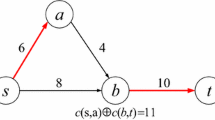Abstract
In this paper, we present a general scheme with which to view reduced load approximations in loss networks. We use notation motivated by stochastic Petri net (SPN) representations of such models and a technique similar to that described by Ciardo and Trivedi for general SPNs. Previous reduced load approximations have involved link independence assumptions. In our method, we assume independence between sets of links rather than between themselves. Our independence assumptions are thus less drastic than those that have been made previously and better results can be expected. Several examples are given in this context.
Similar content being viewed by others
Explore related subjects
Discover the latest articles, news and stories from top researchers in related subjects.References
D.Y. Burman, J.P. Lehoczky and Y. Lim, Insensitivity of blocking probabilities in a circuit switching network, J. Appl. Prob. 21(1984)850–859.
J.P. Buzen, Computational algorithm for closed networks with exponential servers, Comm. Assoc. Comp. Mach. 16(1973)527–531.
G. Chiola, A software package for the analysis of generalised stochastic Petri net models,Proc. Int. Workshop on Timed Petri Nets (IEEE-CS Press, Torino, Italy, 1985).
S.P. Chung and K.W. Ross, Reduced load approximations for multi-rate loss networks,Proc. ITC Specialists Seminar, New Jersey (1990), 11.5.
G. Ciardo, J. Muppala and K.S. Trivedi, SPNO: Stochastic Petri net package,Proc. 3rd Int. Workshop on Petri Nets and Performance Models, Kyoto, Japan (1989) pp. 142–151.
G. Ciardo and K.S. Trivedi, Solution of large GSPN models,Proc. 1st Int. Conf. on the Numerical Solution of Markov Chains, Raleigh, North Carolina (1990).
G. Ciardo and K.S. Trivedi, A decomposition approach for stochastic Petri net models,Proc. on Petri Nets and Performance Models, Melbourne (1991) pp. 74–85.
J.L. Coleman, W. Henderson and P.G. Taylor, A convolution algorithm for calculating exact equilibrium distributions in resource allocation problems with moderate user interference, IEEE Trans. Comm. (1992), to appear.
J.L. Coleman, W. Henderson and P.G. Taylor, Algorithms for evaluating the normalising constant in stochastic Petri nets with product form equilibrium distributions, submitted.
Z. Dziong and J.W. Roberts, Conhestion probabilities in a circuit-switched integrated services network, Perform. Eval. 7(1987)267–284.
D.E. Everitt and N.W. Macfadyen, Analysis of multi-cellular mobile radiotelephone systems with loss, British Telecom Technol. J. 1(1983)37–45.
R.J. Gibbens, P.J. Hunt and F.P. Kelly, Bistability in communication networks,Disorder in Physical Systems, ed. G.R. Grimmett and D.J.A. Welsh (Oxford University Press, 1989) pp. 113–127.
A. Girard,Routing and Dimensioning in Circuit-Switched Networks (Addison-Wesley, 1990).
D.P. Heyman, Asymptotic marginal independence in large networks of loss systems, Ann. Oper. Res. 8(1987)57–73.
B. Hajek and A. Krishna, Bounds on the accuracy of the reduced-load blocking formula in some simple circuit-switched networks,Proc. 1990 BILKNET Int. Conf. on New Trends in Communication, Control and Signal Processing, Ankara, Turkey (1990).
J.M. Holtman, Analysis of dependence effects in telephone trunking networks, Bell Syst. Tech. J. 50(1971)2647–2662.
J.S. Kaufman, Blocking in a shared resource enviroment, IEEE Trans. Comm. 29(1981)1474–1481.
S.S. Katz, Statistical performance analysis of a switched communications network, ITC 5(1967)566–575.
F.P. Kelly, Blocking probabilities in large circuit switched networks, Adv. Appl. Prob. 18(1986)473–505.
F.P. Kelly, Routing in circuit switched networks: Optimisation, shadow prices and decentralisation, Adv. Appl. Prob. 20(1988)112–144.
F.P. Kelly, Loss networks, Ann. Appl. Prob. 1(1991)319–378.
F. Le Gall, About loss probabilities for general routing policies in circuit-switched networks, IEEE Trans. Comm. 37(1989)57–59.
D. Mitra, Some results from an asymptotic analysis of a class of simple, circuit-switched networks,Teletraffic Analysis and Computer Performance Evaluation, ed. Tijms, Boxma and Cohen (Elsevier, New York, 1986) pp. 47–61.
D. Mitra and P.J. Weinberger, Probabilistic models of database locking: Solutions, computational algorithms, and asymptotics, J. Assoc. Comp. Mach. 31(1984)855–878.
W. Whitte, Blocking when service is required from several facilities simultaneously, AT&T Tech. J. 64(1985)1807–1856.
I.B. Ziedins and F.P. Kelly, Limit theorem for loss networks with diverse routing, Adv. Appl. Prob. 21(1989)804–830.
Author information
Authors and Affiliations
Rights and permissions
About this article
Cite this article
Coyle, A.J., Henderson, W. & Taylor, P.G. Reduced load approximations for loss networks. Telecommunication Systems 2, 21–50 (1993). https://doi.org/10.1007/BF02109849
Received:
Revised:
Issue Date:
DOI: https://doi.org/10.1007/BF02109849




